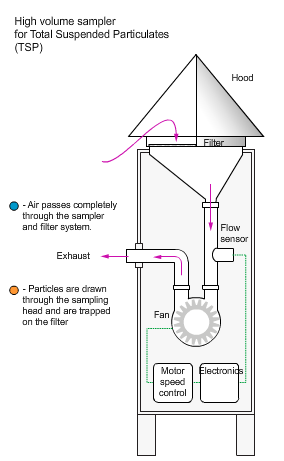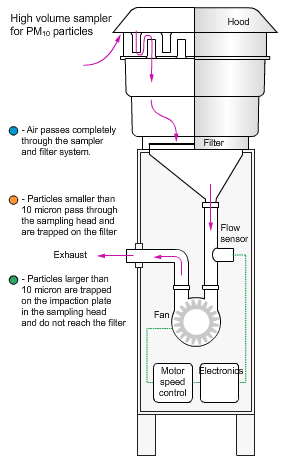High and low volume air samplers
High and low volume air samplers are instruments used to collect samples of air particles.
The difference between high and low volume air samplers is the amount of air sampled.
High volume air samplers typically sample more than 1500 cubic metres (m3) of air over a 24-hour period, while low volume air samplers draw through only 24m3 of air, or less.
Total suspended particulate matter (TSP)
Total suspended particulate matter (TSP) monitoring measures the total amount of particles suspended in the atmosphere.
TSP samples may also be used to determine the levels of chemical elements and compounds in the particles which may pose a risk to human health.
An instrument called a high volume air sampler is used to collect TSP samples. The high volume air sampler draws a large known volume of air through a pre-weighed filter for 24 hours.
As shown in the illustration, the sampler filter traps the TSP particles as air passes through the instrument.

Illustration of a total suspended particulate matter sampler
After sampling, the filter is re-weighed and the difference in filter weight is the collected particulate matter mass. Dividing the mass by the volume of air sampled gives the concentration of TSP.
If required, the particulate matter retained on the filter is analysed to determine the concentration of pollutants, such as lead or other metals. Metals can also be monitored continuously using an XACT instrument.
The design of the air inlet means that a TSP high volume air sampler is unlikely to collect airborne particles with diameters greater than 100 micrometres (µm) in diameter.
This type of sampling usually takes place at 6-day intervals due to the need to manually change the filters.
Particles less than 10 micrometres in diameter (PM10)
Particles smaller than 10µm are especially concerning as these particles can enter the human respiratory system and penetrate deeply into the lungs, causing adverse health effects.
Motor vehicles and other combustion processes that burn fossil fuels such as power stations, industrial processes and domestic heaters, generate PM10. Dust storms and smoke particles from bushfires can also be another source of PM10 missions.
Instruments used to measure PM10 are either a high or low volume air sampler, a tapered element oscillating microbalance (TEOM) or instruments using a light-scattering technique.
The PM10 high or low volume air sampler is similar to that described above for TSP, except that the air sample passes through a size-selective inlet.
The inlet removes particles larger than 10µm by using their greater inertia to trap them on a greased plate, while smaller particles pass through the instrument onto the pre-weighed filter.
The animated illustration of a high volume sampler shows this.

Diagram of a PM10 sampler
Measuring the volume of air sampled and weighing the filters before and after sampling determines the concentration of PM10 particles in the air.
Like the TSP sampler described above, the particles retained on the filter can be analysed to determine the concentration of other pollutants.